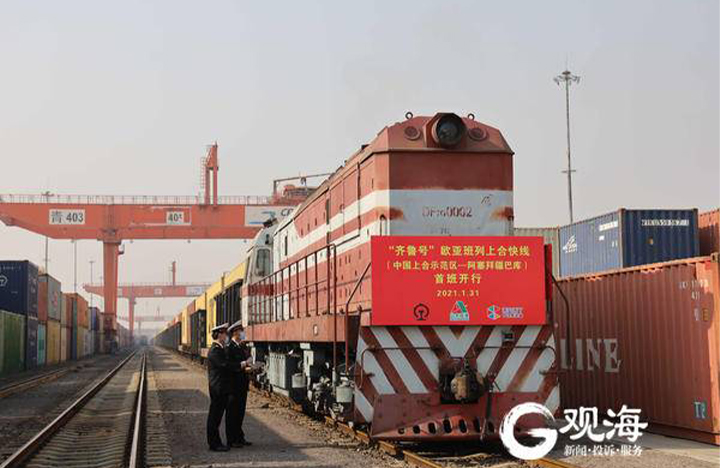



Customs officials in Qingdao, Shandong province, check a freight train bound for Azerbaijan. [Photo/Guanhai]
The Trans-Caspian International Transport Route (TITR), known as the "Middle Corridor," represents a key transportation artery that connects the robust economies of China and Europe. This route traverses China, Kazakhstan, the waters of the Caspian Sea, Azerbaijan, Georgia, and then extends to Turkey and European countries.
Distinguished by its reliability, stability and safety, this route has become the preferred choice for transcontinental freight transportation within the Eurasian region. The appeal of the Middle Corridor continuously attracts market participants' attention and investments, promising significant prospects for deepening trade and economic ties between China and Europe.
Its role as an integral part of the global transportation infrastructure highlights the critical importance of the Middle Corridor in strengthening trade links between Asia and Europe. Its geographical position makes it an optimal route for the movement of goods, combining the efficiency of land and maritime transport. The safety and stability of the corridor, particularly in comparison to alternative routes, render it an indispensable element in the strategy of distributing global freight flows. Its significance also lies in minimizing transit time and reducing logistic costs, which contributes to the growth of trade and the improvement of economic relations between Eurasian countries.
Initially, cargo delivery through the Middle Corridor took 53 days, but this period has now been reduced to 18-23 days. Future plans include further acceleration of delivery, aiming to reduce transit time to 18, and then to 10-15 days.
In this context, Azerbaijan and China, recognizing the importance of the Middle Corridor for their economies, are actively collaborating in its development. This cooperation has become a significant part of the Belt and Road Initiative, aimed at creating an extensive network of trade and infrastructural links. The recent meeting between representatives of the Qingdao Port and the Baku International Sea Trade Port, following the signing of a memorandum of understanding in April 2023, is a key step in strengthening this partnership. The memorandum includes the development of port infrastructure, an increase in cargo volumes and an enhancement of the transit flow, opening new opportunities for transporting goods from East Asian countries through Azerbaijan.
The growing efficiency of the Middle Corridor is evidenced by its recent successes. The arrival of the first block-train from Xi'an to Baku, which successfully delivered cargo in just 11 days, drew particular attention, demonstrating the corridor's potential to reduce delivery times and increase transportation reliability. Active efforts to expand the Baku-Tbilisi-Kars railway corridor, which will allow for an increase in cargo volumes to 5 million tons per year, promise to further strengthen the transportation network and contribute to increasing trade turnover between Asia and Europe.
The Baku International Sea Trade Port, a key point on the Middle Corridor and the largest port on the Caspian Sea, is undergoing modernization. The completion of its second phase of construction will enable the port to handle up to 25 million tons of cargo and 500,000 TEU per year, significantly bolstering Azerbaijan's position in maritime freight transport. The expansion of the shipbuilding yard and the construction of new tankers and dry cargo vessels in Azerbaijan are enhancing cargo turnover and improving the efficiency of logistical operations in the region.
The further development of the "Middle Corridor" promises an ambitious project by China to construct a railway line connecting China with Kyrgyzstan and Uzbekistan. This route includes the ferry transportation of rail and road cargo across the Caspian Sea, followed by delivery through Azerbaijan, Georgia and Turkey via the Baku-Tbilisi-Kars railway line. Such an expansion will not only strengthen the significance of the "Middle Corridor" as a key transportation hub but will also create additional opportunities for increasing cargo volumes and enhancing trade connections in the region.
In 2022, the Middle Corridor saw 103 trains on the China-Europe route, continuing the positive trends of 2021. The addition of new routes from Xi'an, Chongqing, Chengdu and Urumqi led to an increase in the total number of rail directions. In 2023, 2.8 million tons of cargo was transported through the TITR, an 86 percent increase compared to the previous year. Forecasts for 2024 anticipate reaching a volume of 4 million tons, and in the medium-term, a growth to 10 million tons is expected. This significant growth underscores the increasing role of the Middle Corridor in international logistics, particularly in the context of freight transportation from China to Europe.
In conclusion, the Middle Corridor project plays a key role in strengthening regional connections, contributing to the economic and social progress of the countries it traverses. It aligns with the Belt and Road Initiative and safeguards the global supply chain. Strengthening relationships between Azerbaijan and China is crucial for the further development of the Middle Corridor. Working together, these countries enhance the efficiency and reliability of the transport route, expanding trade and economic connections between Asia and Europe. Investments in infrastructure, collaborative projects, and strategic partnership underscore the importance of the Middle Corridor as a vital link in the global transport and trade network, heralding its continued growth and development.
Author: Seymur Mammadov
Source: <https://www.chinadaily.com.cn/a/202402/02/WS65bc5d19a3104efcbdae9577.html>